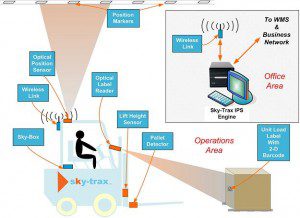More flexible forms of warehouse automation are emerging. One example of this is real-time location forklift automation—i.e., forklifts equipped with a real-time location system that allows drivers to proceed to a specified location and pick up (or put down) a load without the need for the driver to scan the location to prove that they have picked up (or delivered) the right load. This solution is designed for full pallet moves in either a warehouse with racks or a bulk warehouse where pallets are stacked on top of each other.
Based on the number of implementations, it appears that Indyon has emerged as a leader in this area. Indyon is a 20 person firm headquartered in Pöcking, Germany. According to Korbinian Sapper, Indyon’s Sales and Marketing Director, the company has 20 implementations across sites in Germany, Italy, Croatia, and Rumania. Indyon’s customers are primarily from the food and beverage industries.
Indyon uses low-frequency RFID tags placed in the floor of the warehouse or warehouse yard, an antennae array underneath the fork lift, a height sensor that ensures the right pallet in a stack is being picked, and a load sensor that signals the company’s transport control software that a pallet has been loaded. Indyon can integrate its solution with other WMS solutions or implement it with its own software that the company defines as a “lean” solution. However, its lean solution uses real-time location data in different ways than traditional WMS solutions.
For example, through a partnership with Still GmbH, a leading supplier of forklifts, its forklifts can instruct drivers (via their in-cab computer) to slow down because they are entering a zone where foot traffic occurs, or the software can throttle back the forklift to a certain speed limit when passing into this zone. The driver could not go faster than this speed even if he wanted to.
The software can also allow for better driver assignments. By having real-time visibility to where forklifts are, what tasks have been completed, and what tasks are still in the queue, the software can make more agile assignments than a traditional WMS that only has visibility to an event following an RF scan.
The solution also provides rich visualization for both the driver and the warehouse manager. The driver can look at his computer screen and see a diagram of a stack of pallets with the one he has to retrieve highlighted in red. If the driver is facing the wrong stack, no pallet will light up in red. Further, their screen can indicate a preferred path to get to a pick location.
Managers, in turn, can look at a screen and see icons indicating the location of every forklift in the warehouse or yard. If they hover their pointer over a forklift, they can see which load was picked by order and who is driving the forklift.
There are various ways to provide RTLS automation: through location triangulation; through vision systems reading placards on the ceiling; and by starting from a known position and precisely measuring distance and turns. Indyon has experimented with several of these technologies and the company is convinced that RFID works best. With its system, Indyon can consistently, in all environmental conditions, achieve an accuracy that is not off more than 30-35 centimeters, less than half the width of a standard European pallet. If the margin of error is more than half the width of a pallet, which is Indyon’s experience with other methods, the RTLS is not accurate enough to ensure the right pallet is being picked.
The payback from this system comes from better throughput (e.g., drivers don’t have to scan pallets, racks, or trucks) and through fewer errors. Even with scanning, sometimes a driver will scan the right location and then pick from an adjacent spot. I hope to interview an Indyon customer in the near future. I’ll then write another posting on this topic highlighting the customer’s experience with this system and the ROI achieved.

















